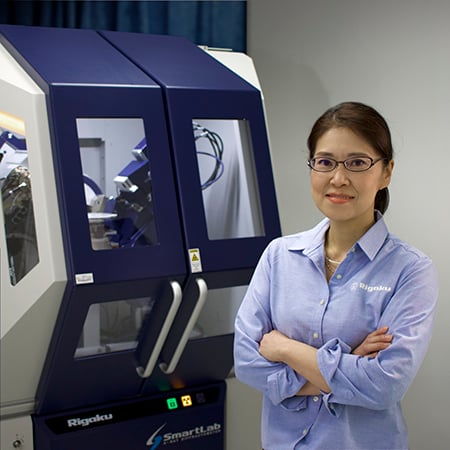Application Note BATT1035
Introduction
Catalysts consisting of platinum nanoparticles supported on gadolinium-doped porous ceria (Gd-doped ceria: GDC) (Pt/ GDC catalysts) have been reported to exhibit better four-electron oxygen reduction reaction activity than commercially available Pt/C catalysts¹. It is important to ensure that the reactions at the catalyst surface in the catalyst bed are facilitated, e.g., by the oxygen and hydrogen gas supply pathways. To understand these properties, it is useful to evaluate the three-dimensional structure of the entire catalyst layer, which is a complex aggregation of nanoparticles. However, with conventional observation methods, it is difficult to nondestructively determine how the nanoparticles are aggregated in three dimensions. By combining small-angle X-ray scattering (SAXS) and reverse Monte Carlo (RMC) methods, it is possible to estimate the three-dimensional aggregation structure of nanoparticles non-destructively and statistically.
Particle size and structure analysis
- Analysis: Fuel cell
- Use: Optimizing electrochemical performance
- Analyzed materials: Pt as catalyst
- Equipment used: Small angle X-ray scattering system
- Analysis software: SAXS3DM
 Figure 1: The resultant structural models obtained by RMC to match the observed SAXS patterns. Red and gray spheres for Pt and GDC particles, respectively.
Figure 1: The resultant structural models obtained by RMC to match the observed SAXS patterns. Red and gray spheres for Pt and GDC particles, respectively.
a) Pt 50wt%, b) Pt 20wt%
 Figure 2: A typical TEM image.
Figure 2: A typical TEM image.
a) Pt 50wt%, b) Pt 20wt%
 Figure 3: The BJH analysis result curves are shown in the dashed lines with the measurement data points in open circles. average curves of three RMC simulations run for SAXS patterns are shown in the solid lines.
Figure 3: The BJH analysis result curves are shown in the dashed lines with the measurement data points in open circles. average curves of three RMC simulations run for SAXS patterns are shown in the solid lines.
Conclusion
The structural model constructed by the combination of SAXS and RMC methods was in good agreement with the TEM observation results. Furthermore, the pore size distribution calculated based on the model was in good agreement with the experimental results obtained by nitrogen gas adsorption, confirming the reproducibility of macroscopic structural indices. These results indicate that the SAXS-RMC method is a very useful 3D structural analysis technique that is superior in both visualization of local structure and statistical structure reproduction.
[1] G. Shi, T. Tano, D. A. Tryk, A. Iiyama, M. Uchida, Y. Kuwauchi, A. Masuda and K. Kakinuma, (2022) J. Catal, 407, 300-311.
Original paper:
T. Iwata, K. Omote, K. Kakinuma, (2024) Rigaku Journal, 40, 1-11.
Omote, T. Iwata, K. Kakinuma, (2023) Adv. Theory Simul. 7(2), 2470006.

